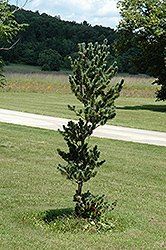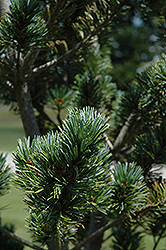Height: 4 feet
Spread: 5 feet
Sunlight:
![]()
Hardiness Zone: 6a
Description:
A very compact and dense form of this picturesque species with small bluish-green needles, forms a small mound, excellent for form, color and texture in home gardens or rock gardens; needs full sun to look its best
Ornamental Features
Dwarf Blue Japanese Pine is a dwarf conifer which is primarily valued in the landscape or garden for its ornamental globe-shaped form. It has attractive bluish-green evergreen foliage. The needles are highly ornamental and remain bluish-green throughout the winter.
Landscape Attributes
Dwarf Blue Japanese Pine is a dense multi-stemmed evergreen shrub with a more or less rounded form. Its relatively fine texture sets it apart from other landscape plants with less refined foliage.
This is a relatively low maintenance shrub. When pruning is necessary, it is recommended to only trim back the new growth of the current season, other than to remove any dieback. It has no significant negative characteristics.
Dwarf Blue Japanese Pine is recommended for the following landscape applications;
- Mass Planting
- General Garden Use
Planting & Growing
Dwarf Blue Japanese Pine will grow to be about 4 feet tall at maturity, with a spread of 5 feet. It tends to fill out right to the ground and therefore doesn't necessarily require facer plants in front. It grows at a slow rate, and under ideal conditions can be expected to live for 50 years or more.
This shrub should only be grown in full sunlight. It prefers dry to average moisture levels with very well-drained soil, and will often die in standing water. It is considered to be drought-tolerant, and thus makes an ideal choice for xeriscaping or the moisture-conserving landscape. It is not particular as to soil type or pH, and is able to handle environmental salt. It is somewhat tolerant of urban pollution. This is a selected variety of a species not originally from North America.
Disclaimer - This resource is provided for informational purposes only and does NOT reflect current availability. Inventory varies seasonally, so we cannot guarantee that every plant will be in stock at all times - please contact your favourite GardenWorks location directly for current availability. It does not include our entire inventory of plants, so be sure to visit GardenWorks to see varieties that may not be represented on this list.


